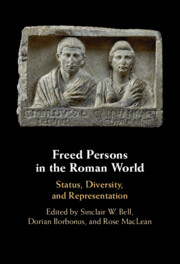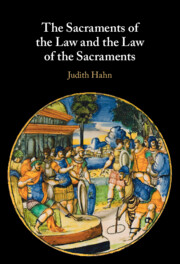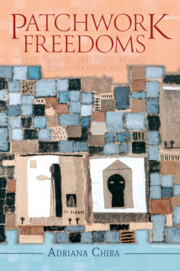40 results
9 - The Affects of Manumission
-
-
- Book:
- Freed Persons in the Roman World
- Published online:
- 16 May 2024
- Print publication:
- 23 May 2024, pp 242-277
-
- Chapter
- Export citation
4 - Doubling Up
-
-
- Book:
- Freed Persons in the Roman World
- Published online:
- 16 May 2024
- Print publication:
- 23 May 2024, pp 119-140
-
- Chapter
- Export citation
6 - Between Moral Slavery and Legal Freedom
-
-
- Book:
- Freed Persons in the Roman World
- Published online:
- 16 May 2024
- Print publication:
- 23 May 2024, pp 164-188
-
- Chapter
- Export citation
Introduction
-
-
- Book:
- Freed Persons in the Roman World
- Published online:
- 16 May 2024
- Print publication:
- 23 May 2024, pp 1-29
-
- Chapter
- Export citation

Freed Persons in the Roman World
- Status, Diversity, and Representation
-
- Published online:
- 16 May 2024
- Print publication:
- 23 May 2024
6 - Roman Egypt
-
- Book:
- Slavery and Dependence in Ancient Egypt
- Published online:
- 01 March 2024
- Print publication:
- 21 March 2024, pp 274-342
-
- Chapter
- Export citation
The Escribano of Babel: Power, Exile, and Enslavement in the Venezuelan Llanos During the War of Independence (1806–1833)
-
- Journal:
- The Americas , First View
- Published online by Cambridge University Press:
- 22 December 2023, pp. 1-28
-
- Article
-
- You have access
- Open access
- HTML
- Export citation
2 - “Old and broken now; no tongue can tell how much I suffer”
- from Part I - The Enslaved
-
- Book:
- Old Age and American Slavery
- Published online:
- 27 October 2023
- Print publication:
- 16 November 2023, pp 72-104
-
- Chapter
- Export citation
10 - “Let our women and old men … be disabused of the false and unfounded notion that slavery is sinful”
- from Part II - Enslavers
-
- Book:
- Old Age and American Slavery
- Published online:
- 27 October 2023
- Print publication:
- 16 November 2023, pp 318-345
-
- Chapter
- Export citation

The Sacraments of the Law and the Law of the Sacraments
-
- Published online:
- 09 November 2023
- Print publication:
- 23 November 2023
9 - Freedom and Unfreedom
- from Part II - The Laity
-
- Book:
- Beyond the Monastery Walls
- Published online:
- 09 December 2022
- Print publication:
- 29 December 2022, pp 284-320
-
- Chapter
- Export citation
1 - Rebels and Refugees
-
- Book:
- Staging Haiti in Nineteenth-Century America
- Published online:
- 18 November 2022
- Print publication:
- 01 December 2022, pp 33-60
-
- Chapter
- Export citation
5 - Branded in Freedom
-
- Book:
- Wealth, Land, and Property in Angola
- Published online:
- 22 September 2022
- Print publication:
- 29 September 2022, pp 168-197
-
- Chapter
- Export citation
14 - What Did Thomson, Watson & Co. Purchase?
-
- Book:
- Our Long Walk to Economic Freedom
- Published online:
- 30 August 2022
- Print publication:
- 04 August 2022, pp 78-82
-
- Chapter
- Export citation
Chapter 13 - The Black Child, the Colonial Orphan, and Early Republican Visions of Freedom
- from Part II - Networks
-
-
- Book:
- American Literature in Transition, 1770–1828
- Published online:
- 09 June 2022
- Print publication:
- 23 June 2022, pp 231-248
-
- Chapter
- Export citation
Introduction
-
- Book:
- Patchwork Freedoms
- Published online:
- 10 February 2022
- Print publication:
- 17 February 2022, pp 1-29
-
- Chapter
- Export citation
4 - Manumission’s Legalities
-
- Book:
- Patchwork Freedoms
- Published online:
- 10 February 2022
- Print publication:
- 17 February 2022, pp 142-179
-
- Chapter
- Export citation
3 - Keeping People Put
-
- Book:
- Patchwork Freedoms
- Published online:
- 10 February 2022
- Print publication:
- 17 February 2022, pp 105-141
-
- Chapter
- Export citation
5 - “A Freedom with Further Bonds”
-
- Book:
- Patchwork Freedoms
- Published online:
- 10 February 2022
- Print publication:
- 17 February 2022, pp 180-224
-
- Chapter
- Export citation

Patchwork Freedoms
- Law, Slavery, and Race beyond Cuba's Plantations
-
- Published online:
- 10 February 2022
- Print publication:
- 17 February 2022



